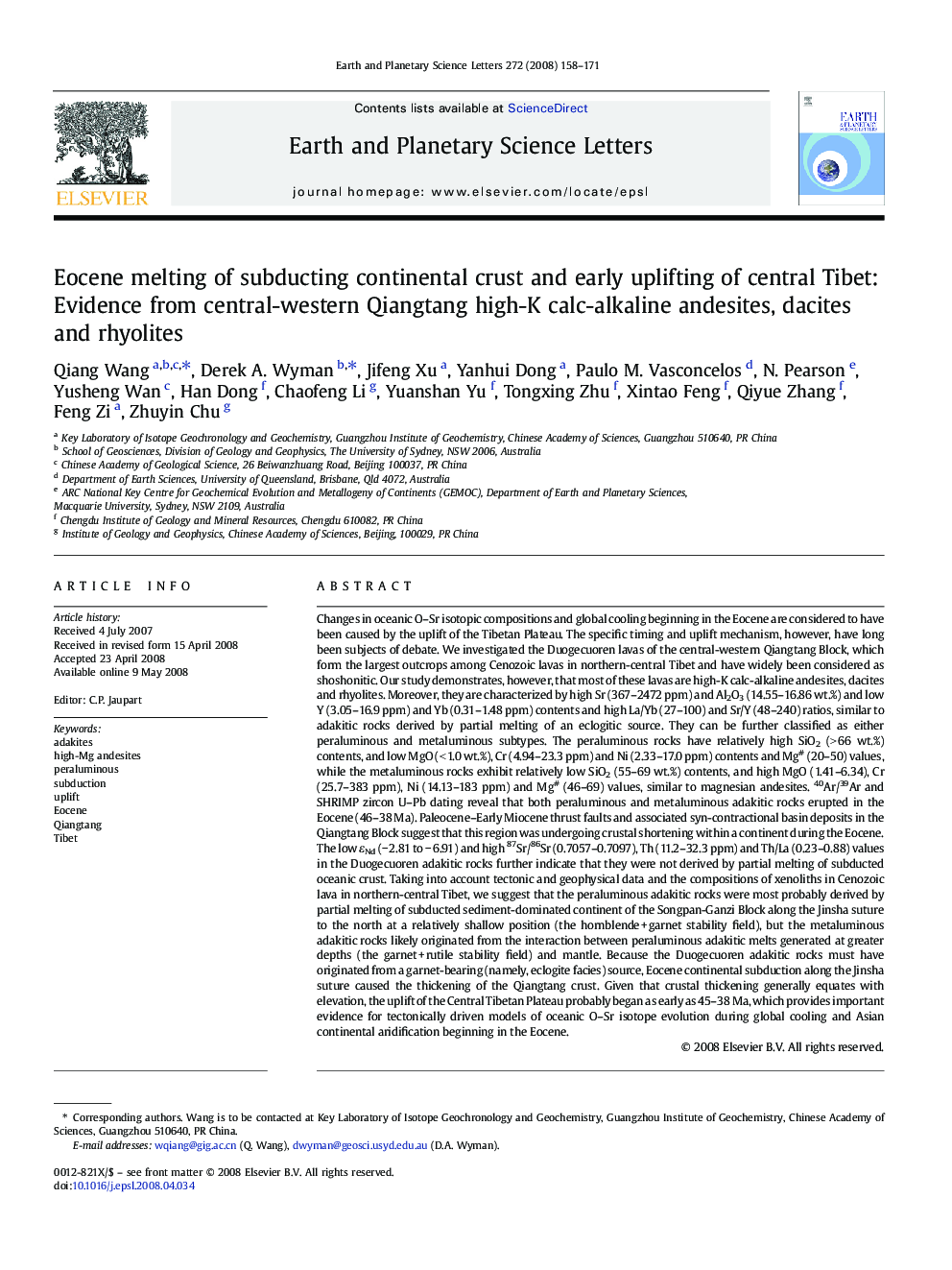| کد مقاله | کد نشریه | سال انتشار | مقاله انگلیسی | نسخه تمام متن |
|---|---|---|---|---|
| 4679693 | 1634892 | 2008 | 14 صفحه PDF | دانلود رایگان |

Changes in oceanic O–Sr isotopic compositions and global cooling beginning in the Eocene are considered to have been caused by the uplift of the Tibetan Plateau. The specific timing and uplift mechanism, however, have long been subjects of debate. We investigated the Duogecuoren lavas of the central-western Qiangtang Block, which form the largest outcrops among Cenozoic lavas in northern-central Tibet and have widely been considered as shoshonitic. Our study demonstrates, however, that most of these lavas are high-K calc-alkaline andesites, dacites and rhyolites. Moreover, they are characterized by high Sr (367–2472 ppm) and Al2O3 (14.55–16.86 wt.%) and low Y (3.05–16.9 ppm) and Yb (0.31–1.48 ppm) contents and high La/Yb (27–100) and Sr/Y (48–240) ratios, similar to adakitic rocks derived by partial melting of an eclogitic source. They can be further classified as either peraluminous and metaluminous subtypes. The peraluminous rocks have relatively high SiO2 (> 66 wt.%) contents, and low MgO (< 1.0 wt.%), Cr (4.94–23.3 ppm) and Ni (2.33–17.0 ppm) contents and Mg# (20–50) values, while the metaluminous rocks exhibit relatively low SiO2 (55–69 wt.%) contents, and high MgO (1.41–6.34), Cr (25.7–383 ppm), Ni (14.13–183 ppm) and Mg# (46–69) values, similar to magnesian andesites. 40Ar/39Ar and SHRIMP zircon U–Pb dating reveal that both peraluminous and metaluminous adakitic rocks erupted in the Eocene (46–38 Ma). Paleocene–Early Miocene thrust faults and associated syn-contractional basin deposits in the Qiangtang Block suggest that this region was undergoing crustal shortening within a continent during the Eocene. The low εNd (− 2.81 to − 6.91) and high 87Sr/86Sr (0.7057–0.7097), Th (11.2–32.3 ppm) and Th/La (0.23–0.88) values in the Duogecuoren adakitic rocks further indicate that they were not derived by partial melting of subducted oceanic crust. Taking into account tectonic and geophysical data and the compositions of xenoliths in Cenozoic lava in northern-central Tibet, we suggest that the peraluminous adakitic rocks were most probably derived by partial melting of subducted sediment-dominated continent of the Songpan-Ganzi Block along the Jinsha suture to the north at a relatively shallow position (the hornblende + garnet stability field), but the metaluminous adakitic rocks likely originated from the interaction between peraluminous adakitic melts generated at greater depths (the garnet + rutile stability field) and mantle. Because the Duogecuoren adakitic rocks must have originated from a garnet-bearing (namely, eclogite facies) source, Eocene continental subduction along the Jinsha suture caused the thickening of the Qiangtang crust. Given that crustal thickening generally equates with elevation, the uplift of the Central Tibetan Plateau probably began as early as 45–38 Ma, which provides important evidence for tectonically driven models of oceanic O–Sr isotope evolution during global cooling and Asian continental aridification beginning in the Eocene.
Journal: Earth and Planetary Science Letters - Volume 272, Issues 1–2, 30 July 2008, Pages 158–171